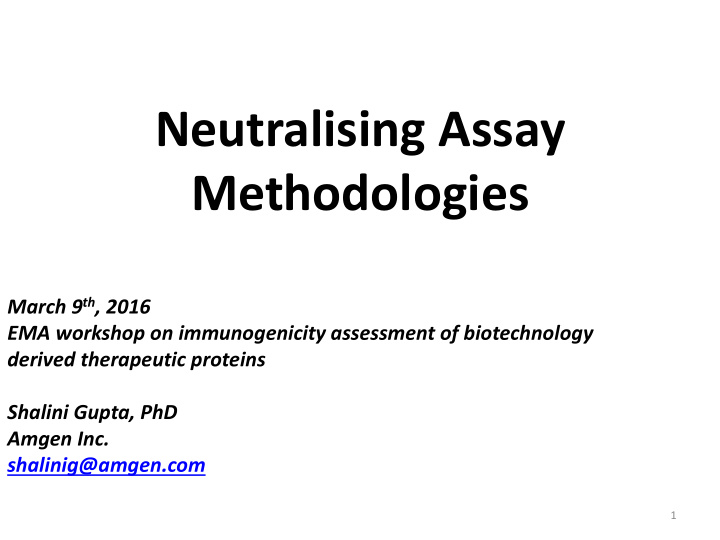



Neutralising Assay Methodologies March 9 th , 2016 EMA workshop on immunogenicity assessment of biotechnology derived therapeutic proteins Shalini Gupta, PhD Amgen Inc. shalinig@amgen.com 1
Key Points About Neutralising Antibodies 1. Definition • These types of anti-drug antibodies (ADAs) interfere with the biological activity of the drug 2. Impact of NAbs to • Could range from none to serious impact patient depending upon the magnitude of NAbs produced resulting in reduced exposure and/or efficacy 3. NAb testing strategy • 2 nd tier of immunogenicity assays • NAb test is usually preceded by a binding ADA test 4. NAb methodologies • Functional in vitro serum-based assays capable of assessing change in the biological activity of the drug • Cell-based • Non cell-based (Ligand binding) • Qualitative determination 5. Characterization of • Titer (serial dilution of sample/fixed drug conc) NAbs • Quasi-quantitative determination 2
NAb Assay Methodologies Goal : To detect clinically relevant NAbs Cell based Non cell based Pros Cons Pros Cons Physiological Binding ability of drug Complex Simpler is measured Response of drug Is measured Assay characteristics : Sensitivity, specificity, drug product tolerance, reproducibility The decision to use a cell-based or non cell based NAb assay is inconsistent across industry 3
Direct Cell-Based Assay Measuring Proliferation Cells only Cells + Drug Cells +Drug + Anti-Drug Ab Proliferation Assay Response Baseline Inhibition of Proliferation Cells only Drug Control NAb Positive 4 Control
Direct Competitive Ligand Binding Assay Ruthenylated Ruthenylated Drug Drug Anti-Drug NAb Target Electric Current ECL plate wells Drug Control = Positive Control = High signal No or low signal Instead of cells, the assay uses purified preparation of the target protein that the drug binds to 5
Assessment of Specificity of NAb assays NAb Assay Matrix MIA Type Examples Format interference Assay Format Effect of sample Cytokines, on cell response ALTERNATIVE Direct Cell by another Growth Factors, Based STIMULUS stimulus agonistic MAbs (uses a factor- dependent cell line) Effect of sample MAbs, soluble on cell response SAMPLE Indirect Cell in absence of receptors Based INDUCED added drug RESPONSE and/or ligand Sample All types of pretreatment IMMUNO biological Direct or with protein G/L therapeutics Indirect Cell DEPLETION followed by test based or Non in NAb assay cell based
Need for a consistent NAb assay selection strategy across Industry Regulatory Year Type of Biological Guidance for NAb assay Additional text Agency Therapeutic/Area Format EMA 2007 Biotechnology-derived Functional bioassay Adaptation of therapeutic proteins potency assay EMA 2012 Monoclonal Competitive ligand Cell based assays Antibodies binding assays may offer an advantage FDA (draft) 2009 Therapeutic proteins Cell based bioassay Should reflect (Assay Development) the product’s mechanism of action FDA 2014 Therapeutic proteins Appropriate Impact of NAbs (Immunogenicity immunogenicity assays on life saving assessment) should be implemented drugs 7
AAPS LBABFG/Immunogenicity Assay Working Group Committee Name Company Shalini Gupta, Chair Amgen Renuka Pillutla Bristol Myers Squibb Yuanxin Xu Genzyme, Sanofi Xu-Rong Jiang MedImmune, Astra Zeneca Shan Chung Genentech Manoj Rajadhyaksha Regeneron Joleen White EMD Serono Jim McNally EMD Serono Bonnie Wu (Lead Author) Janssen, J&J Joao Pedras-Vasconcelos FDA 8
White Paper (in draft) • Title – Strategies to Determine Assay Format for the Assessment of Neutralizing Antibody Responses to Biotherapeutics • In-Scope – Provide guiding principles for decision making strategy to use a cell-based or non cell-based NAb assay • Out of Scope – Recommendation to include/exclude NAb testing in immunogenicity strategy • Timing – Paper submission to Journal targeted by Q1 2016 9
Considerations for selection of NAb assay format Therapeutic MoA Examples: • Agonists • Antagonists • Multiple domain biotherapeutics - Multi-specific biotherapeutics - ADCs - Effector function mAbs • Enzyme biotherapeutics • Etc. Primary Determinant (Cell-based vs Non Cell-based Assay?) Assay Performance Risk Assessment Characteristics • High risk biotherapeutics • Sensitivity - high risk to patient • Specificity mediated by NAbs • Selectivity • Low to medium risk - drug tolerance biotherapeutics - target tolerance - Moderate and • Precision manageable risk • Robustness • Etc. Indicators of Assay Reliability For Shaping the Assay Expectations 10 A reliable NAb assay should be able to detect clinical relevant NAbs.
Biologic Therapeutics Categorized by MoA Enzyme Therapeutic Agonist Antibody Drug Antagonist Therapeutic Antibody with Conjugate (ADC) Effector Function ADC delivers drug into cells Therapeutic Soluble Enzyme against humoral receptor functions in target circulation Cell-based assay Recommended Non-cell Non-cell Cell-based based assay based CLBA assay preferred; Cell-based CLBA acceptable effector assay Enzyme functions in Cell-based cells functional assay Other acceptable formats Therapeutic competitively Cell-based blocks receptor assay or Bispecific drug will follow non-cell Cell-based binding based assay the decision tree for each assay and/or non-cell Cell-based based CLBA targeting entity assay or non-cell based CLBA 11 USP Chapter 1106
Bioanalytical Perspective On Trigger-based NAb testing • Regulatory input is important for this approach • The “trigger” needs to be well-defined • Bioanalytical efforts are still needed to prepare if a clinical “trigger” is observed – NAb assay format selection – Availability of a NAb positive control – Level of assay development, qualification and/or validation needs thought • NAb+/- results originating from a NAb test enable easier study interpretation 12
Conclusions • NAb assays are qualitative assays • A well-designed NAb assay should be able to detect clinically relevant NAbs • Efforts are ongoing in industry to compile recommendations for consistent use of cell- based and non cell-based NAb assays • Bioanalytical approaches for “Trigger”-based NAb assay availability need discussion 13
Recommend
More recommend